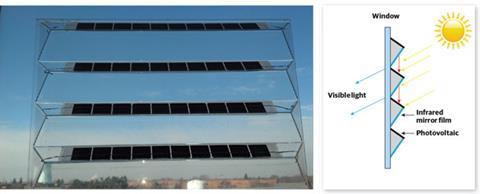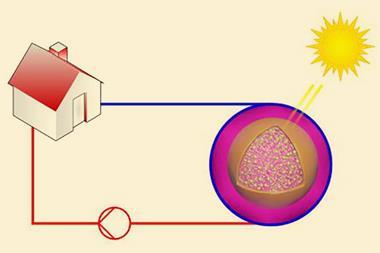How can chemistry help reduce the energy consumption of our houses? Fiona Case shares a blueprint for the buildings of tomorrow
How can chemistry help reduce the energy consumption of our houses? Fiona Case shares a blueprint for the buildings of tomorrow

Prompted in part by research funding initiatives (the European energy efficient buildings public–private partnership in research, or EeB PPP, and the US Department of Energy), a range of new materials are being developed that promise significant improvements in the carbon-footprint of buildings.
Insulation
The key property for building insulation is thermal conductivity; the lower, the better. Traditional insulation materials such as mineral wools, expanded polystyrene, cellulose or polyurethane foam have thermal conductivities from 25 to 50mW/m.K. These are clearly beneficial, but there is plenty of room for improvement. ‘A significant contributor to thermal conductivity is from the heat transport through collisions between gas molecules within the material,’ explains Bjørn Petter Jelle, senior research scientist at SINTEF Building and Infrastructure in Trondheim, Norway. ‘A vacuum insulation panel has a thermal conductivity as low as 4mW/m.K, but as soon as you make a hole and allow the air in it increases to 20mW/m.K.’ This is a drawback for a construction material that might easily be damaged or punctured by nails. Nanoporous materials provide a more flexible alternative. ‘If the pore diameter is less than the mean free path for the gas (40nm for air), the molecules will not hit each other before they hit the pore walls and the thermal conductivity becomes very low, even with air-filled pores,’ explains Jelle.

Nasa’s Glenn Research Center in Cleveland, US, has recently developed nanoporous polyimide aerogels with thermal conductivities in line with silica aerogels, but up to 500 times stronger. ‘Our material can withstand the weight of a car,’ says Amy Hiltabidel, a technology transfer specialist at Nasa. ‘Since August 2012 we have been approached by over 70 companies, each with a different application in mind. We are in active discussions with several companies that offer solutions to the building industry,’ she adds.
But there is a downside to all this insulation: ‘Highly insulated buildings in the future will become prone to overheating’ warns Julia Buchner, senior manager of corporate media relations for BASF in Ludwigshafen, Germany. ‘Phase change materials (PCMs) can significantly reduce this effect because they provide thermal mass to absorb and store this heat.’
BASF’s phase change material consists of microscopic plastic capsules with a wax core. On melting, they absorb large amounts of heat from the environment, preventing the room temperature from rising further. At night, when the outside temperatures fall again, the heat is released again and warms the building.
‘The European NanoPCM consortium aims to develop cheaper methods of production and new types of phase change materials,’ says project coordinator Jose Cubillo, a researcher with Spanish construction firm Acciona in Madrid.
‘We spray-dry low molecular weight polyethylene microcapsules with silica or LDPE [low density polyethylene] shells and incorporate them into polyurethane-foam-based insulation panels,’ he explains. ‘The outside temperature can change quite quickly, so we add carbon nanofibres to increase thermal conductivity within the microcapsule and increase the rate of the phase change to capture or release that thermal energy.’
The temperature range for phase change can be tailored by changing the polyethylene molecular weight for different climates. ‘We have two test sites, one in Warsaw, Poland, and one in Madrid, Spain,’ says Cubillo. ‘If we used the material we designed for Madrid in Poland it would never melt.’
The NanoPCM project will complete this summer. ‘We have developed a pilot plant and we are collecting final results from the test installations,’ says Cubillo. ‘We are looking for companies who might want to take this on and develop it into a commercial product.’
Windows
The windows on a green building also need to provide thermal insulation. Current solutions include double or triple glazing with vacuum or noble gas filling to inhibit thermal conduction. Cabot’s silica aerogel is used in opaque windows to provide diffuse daylight with low thermal conductivity. ‘Silica aerogels can also be made transparent,’ says Jelle. ‘If that material could be scaled up and made commercial, it would be widely used.’
A significant issue for windows is the heating effect of sunshine streaming through, causing air conditioners to run at full power on a sunny day. ‘Switchable windows can control transmitted light and solar heat,’ says Jelle. ‘Most use electrochromic films which reversibly change their optical properties as ions are inserted or extracted by an external potential,’ he explains. ‘They block sunlight from entering a room, but they absorb the energy which is reemitted as heat.’

But what if you could do something useful with that reflected near-infrared solar energy? That’s what 3M, based in St Paul, US, aims to achieve. Their wavelength selective infrared mirror window films reflect useful solar energy onto photovoltaic modules while transmitting light into the building.
‘This is a new application of the quarter wave constructive interference films that 3M developed 20 years ago,’ says Tim Hebrink, a staff scientist at 3M. ‘Wavelength-selective reflective film technology is similar to the colourful interference patterns you see from films of oil on water, only instead of one thin film layer, we have hundreds of layers working constructively to reflect a broader bandwidth of light,’ he explains. ‘We adjust the thickness and refractive indices of the polymer layers to select wavelengths between 700nm and 1200nm – which is the range within which silicon-based photovoltaics have a peak response, and which heats rooms without providing useful illumination – and we direct it onto solar cells mounted near the window.’
‘You can reduce air conditioning energy use, save energy with the use of natural daylight, and increase the peak efficiency of the solar cells by 40%’ says Hebrink. ‘We are donating demonstration modules to several universities and the Minnesota Science Museum in St Paul and are now looking for companies to commercialise the modules.’
Lighting
Over the last decade most people have replaced inefficient incandescent light bulbs with compact fluroescents, and increasingly with inorganic light emitting diodes (LEDs). What more can we do?
Lynn Davis, director of engineering research at RTI International in Raleigh-Durham, US, suggests that we look at the reflective surfaces of light fittings. ‘Traditional reflector materials such as paints and metallised plastics can absorb substantial amounts of light,’ he explains. RTI have developed photoluminescent nanofibres by coating electrospun polymer nanofibres with luminescent particles such as quantum dots. ‘The reflectance of these nanofibre materials can be as high as 0.98, they can increase the light by as much as 40% and yield significant energy savings,’ Davis explains. ‘We are aggressively seeking to commercialise this material in 2013 and are currently screening manufacturing partners,’ he adds.

‘The potential difference between the two electrodes creates a displacement current in the polymer, leading to the formation of excitons as charge is redistributed in the delocalised structure,’ he says. Light is emitted as the polymer relaxes back to its ground state, aided by organometallic scavengers. ‘You can have up to 10% variation in film thickness which permits you to use conventional film manufacturing techniques,’ he explains.
The Carroll group have created three different delocalised polymer structures, and three different scavengers. ‘That gives us six different knobs to turn to tune the colour of the light,’ he explains. Carroll is partnering with US company Ceelight Technologies of Colmar, Pennsylvania, to develop lightbulbs that will be durable drop-in replacements for incandescent or compact fluorescent bulbs.
Concrete

A more radical approach would be to create a completely different kind of concrete: a material that makes use of waste currently destined for landfill, that has a low or even negative carbon footprint and is a better thermal insulator. ‘We can use waste ash to replace the binder (cement), at least for the factory-made ready mix concrete,’ says Marios Soutsos, who works on concrete technology at the Centre for Built Environment Research at Queen’s University Belfast, UK. ‘About half of the ash from coal-powered electricity generating stations is sent to long-term storage; we estimate there are around 56 million tonnes in the UK alone.’ The material is already used as an additive for cement. ‘To entirely replace the kiln-baked clay and limestone, we need to get the silicates from the ash in solution to form sodium aluminosilicate – a geopolymer binder,’ he explains.
Soutsos’ group is testing pre-treatment of the ash with concentrated sodium hydroxide. They are also looking at ‘red mud’ – the waste alkali sludge made infamous by the Ajka alumina plant disaster in October 2010 when it caused death and environmental havoc as it poured across the Hungarian landscape. ‘It would be good to find a use for this material,’ says Soutsos.
They have also discovered that adding ground blast furnace slag – the material that floats to the surface when iron ore is smelted with limestone and coke to create steel – dramatically increases the setting rate and enables cementless concrete to be used for site construction. ‘Every tonne of Portland cement embodies 930kg of carbon dioxide. Our new geopolymers are based on ash, which has a footprint of only 4kg of carbon dioxide per tonne,’ says Soutsos.
Will we see the harvest?
Stefano Carosio, executive board member of the Energy Efficient Buildings Association, working with the EeB PPP program, is proud of the success of the European funding initiative. ‘We’ve created a network of materials scientists and practitioners working closely with construction experts and designers,’ he says. The initiative has been a significant source of funding for European research on innovative materials for green buildings. ‘Projects end with prototypes, with demonstration of manufacturability and integration in demo buildings,’ Carosio explains. ‘We are however still in pre-competitive research: companies need to take on these new materials and optimise their production to bring them to market, but since the financial crisis the resources for engineering new products in industry have been greatly reduced.’
The collaborations are also needed to work on the non-technological barriers to adoption of the new materials. ‘One challenge is updating building standards. New methods are needed to measure the effectiveness of insulation, for instance, when it contains phase change materials,’ explains Carosio. ‘Unless the efficiency of these novel features is part of standards and best practices there is no incentive.’
The EeB PPP is due to end this year although there is lobbying to extend it for another seven years. Carosio is concerned that many of the innovative ideas and prototypes may die on the vine if resources are suddenly stopped. ‘There is a risk that promising materials that are currently in development will never make it into the market place.’
Fiona Case is a science writer based in San Diego, California, US













No comments yet